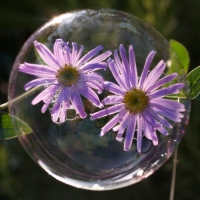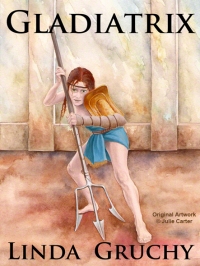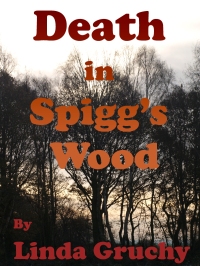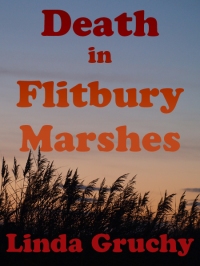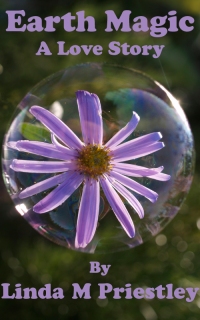I am very lucky to live near Tiptree Heath, an area of Special Scientific Interest and the largest surviving fragment of heathland in Essex.
It’s a good place to go for a walk, and beloved by many dog walkers. I don’t have a dog, and this has caused consternation amongst some dog walkers. I was once greeted with, “Ah, that’s all right; you’re a woman.” Seeing my perplexed expression, the dog walker explained that blokes without dogs are automatically suspected as flashers or molesters!
The heathland is under threat from invasive species like silver birch, which is a primary coloniser. If this is permitted to grow up it will become scrubland and woodland, and we will lose that unique habitat. There are some beautiful, mature silver birches, but they have seeded into one of the wide open spaces where the heather grows. This is currently controlled in three ways. In winter it’s browsed by Exmoor ponies, in summer, it’s grazed by Dexter cattle, and the woody scrub is scraped off to allow the heather to grow.
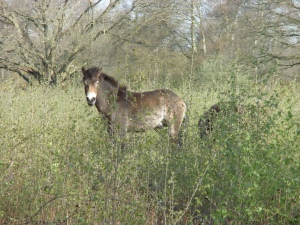 [Exmoor pony in the stands of birch, munching away on the leaves and twigs.]
[Exmoor pony in the stands of birch, munching away on the leaves and twigs.]
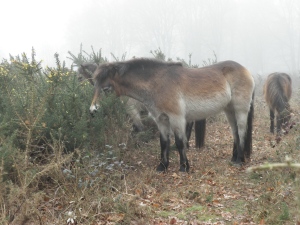 [The ponies also have a taste for gorse, which seems like a prickly mouthful to me. Apparently they fold it backwards before chewing so that it doesn’t prickle.]
[The ponies also have a taste for gorse, which seems like a prickly mouthful to me. Apparently they fold it backwards before chewing so that it doesn’t prickle.]
I noticed that the silver birch last year have grown up, partly because the scraping tends to coppice rather than uproot, but it’s the only cost-effective way of maintaining the open space… the Friends of Tiptree Heath are volunteers who give up their time to help maintain it, but it’s a huge task, one impossible to undertake by hand.
Wondering where I was going to do for pea sticks this year, I suddenly remembered this forest of seedling trees, so I contacted the warden Joan Pinch with the idea that gardeners might like to buy a bundle of pea sticks, thereby raising funds for the heath maintenance and at the same time, taking away some of these weeds.
The heathland ecology relies on poor soils, so losing such material from the heath would be a benefit. One problem with the dogs is some of them deposit high nitrogenous waste despite the availability of bins. This enriches the soil, causing rank growth of plants which favour rich soils, like stinging nettles.
Joan the warden thought it a good idea, but that’s as far as it’s gone this year, except that I have taken a couple of bundles to get some idea of how feasible it is and to take photographs to show people how to use the pea sticks. It’s not just peas which benefit from pea sticks. I went to a workshop at RHS Hyde Hall where they use sticks tangled together to make natural looking and unobtrusive plant supports. Birch is ideal for this as it’s flexible and easily bent into a support.
I found that it didn’t take long to cut a bundle of sticks, though of course, this is just coppicing again and not getting rid of the trees, so not curing the problem long-term. I have a poor garden for growing veg so I grow a lot in tubs. I’ve posted some photos of the pea sticks in action below.
 [The birch twigs are pushed into the soil, then bent over and twisted round to make the supports.]
[The birch twigs are pushed into the soil, then bent over and twisted round to make the supports.]
So that’s the pea sticks in this post; what about the pollution? I’m talking genetic pollution. The other day Joan the Warden remarked that someone had said that she’d had a report that there were some Spanish bluebells in the heath. I was a bit disturbed because the only ones I remembered seeing were the Hyacinthoides non-scripta, the English bluebells. I love these and was afraid they might be destroyed in error, so I kept my eye open for this patch of Spanish Bluebells (H hispanica).
The ways to tell the difference are:-
The pollen of the English bluebell is creamy white. In Spanish bluebells this is greenish blue. In hybrids it’s usually green-blue, but not always.
The flowers of the English bluebell are that intense deep blue, almost indigo, and that’s what I love about them. The tube is narrow and the tepal tips deeply curled back. The flower heads curl over to one side. White forms do appear. The Spanish bluebells and intermediate cross breeds are sturdier, the leaves wider and more strap-like the flowers broader and the tepals not as recurved. They are very pretty and this makes them emotionally difficult to weed out in the garden, but they are also promiscuous and grow like thugs, sending out side shoots underground and spreading that way. They do not, repeat, not belong in the wild because they genetically contaminate that national treasure, the English bluebell.
 [These are from my garden showing the differences between H. hispanica and H. non-scripta. Even here I suspect my non-scripta are genetically impure because ther tube is foreshortened. They may even all be hybrids.]
[These are from my garden showing the differences between H. hispanica and H. non-scripta. Even here I suspect my non-scripta are genetically impure because ther tube is foreshortened. They may even all be hybrids.]
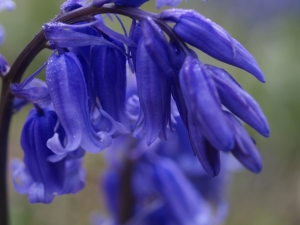 [True English Bluebell showing that intense blue, curly tepals and nodding habit. Just beautiful.]
[True English Bluebell showing that intense blue, curly tepals and nodding habit. Just beautiful.]
 [White forms of H. noscripta.]
[White forms of H. noscripta.]
In the past I bought what was described as English Bluebells, H. nonscripta, and found they were in fact hybrids. I wish I had kept the receipt. Unfortunately many of our bluebells in towns and villages are hybrids and it’s difficult to not get genetic contamination, so plants which look like the English type often bear some Spanish genes.
I looked round the heath for these genetically impure thugs, checking and photographing the pollen anthers on all the bluebell patches I found. The closest I came was where someone’s bluebells have escaped from their garden onto the edge of the heath. The pollen was creamy white but the tepals were not as curly as normal and the fact some had large, strap-like leaves, suggested ‘hybrid’ to me, but with mainly English genes.
 [I found these with suspect ancestry, though the pollen was yellow. They look mainly true to English type.]
[I found these with suspect ancestry, though the pollen was yellow. They look mainly true to English type.]
 [Compare the above with these true English bluebells I photographed a few miles away last year. Are they not the most exquisite of plants?]
[Compare the above with these true English bluebells I photographed a few miles away last year. Are they not the most exquisite of plants?]
 [This photo was from the first group on Tiptree Heath, furthest from the road, and least likely to be genetically contaminated.]
[This photo was from the first group on Tiptree Heath, furthest from the road, and least likely to be genetically contaminated.]
I thought the most likely place for dumped bluebells would be close to the car park where naughty people might be tempted to dump their garden waste. Idle types like this aren’t likely to walk half a mile before dumping. But I didn’t find any that day (but I didn’t look everywhere).
The next time I walked round the heath I looked close to the road and found one hybrid. Then, near where the old, unofficial car park has been closed after an unfortunate pollution incident from a lorry, I found the blighters. Definitely hybrids. Not only that, whoever had dumped them had dumped Montbretia too. Neither belong in this place of special scientific interest. Both can be invasive. People seem blissfully unaware of the damage they can cause by putting garden waste in the wild. In fact, judging by the position I do wonder if they weren’t deliberately planted by someone with well-meaning and romantic notions about making the place look pretty. (I would expect dumping from idle types to be close by the road.)
I have spent the last couple of years pulling up my Spanish bluebells and either putting them in pots so I can enjoy the flowers but not have to put up with the thuggishness, or putting them in the green waste, which should get hot enough to kill the bulbs and seeds. But they’re so pretty is seems a shame to destroy them, and I think this is why well-meaning but ignorant people put their excess plants in the woods like this.
I know that bees which visit my Spanish bluebells will visit the English ones nearby, making hybrids, but I am in a village and for our village bluebells it’s too late, genetic purity has been lost. The genie (gene) is out of the bottle. But in the countryside that genetic purity must be safeguarded wherever possible.
[These photographs are my copyright. If you wish to use them please contact me.]





